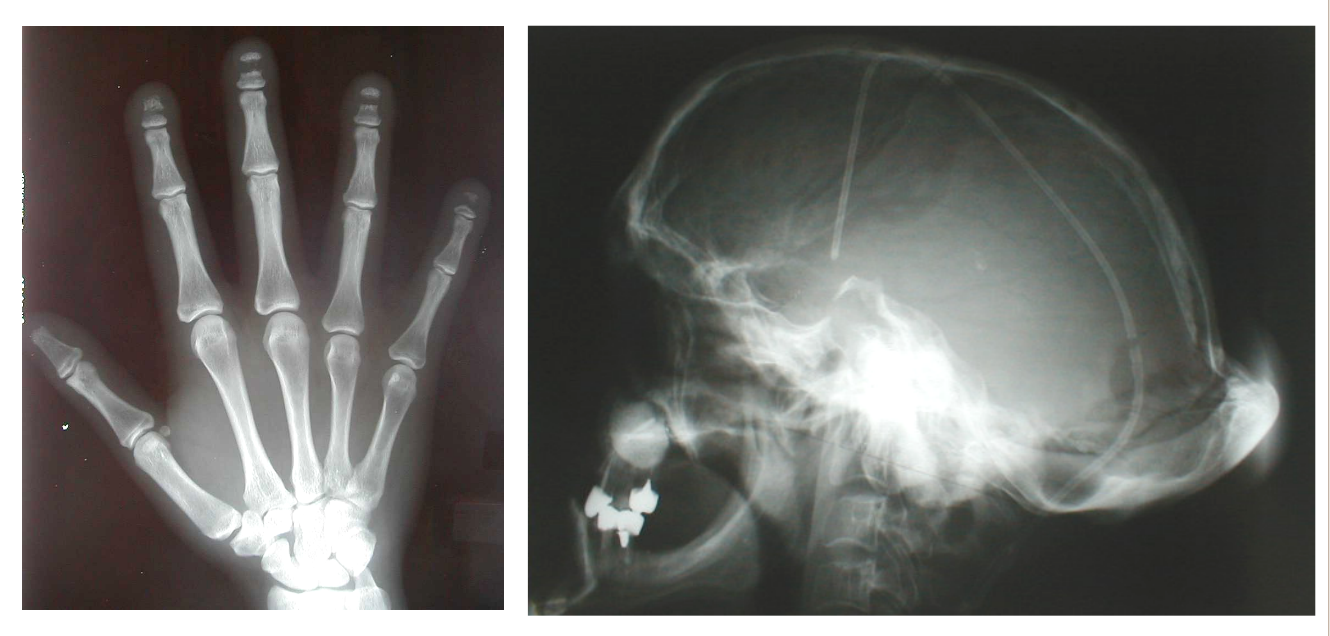Hajdu–Cheney syndrome
(Redirected from Arthrodentoosteodysplasia)
Editor-In-Chief: Prab R Tumpati, MD
Obesity, Sleep & Internal medicine
Founder, WikiMD Wellnesspedia &
W8MD medical weight loss NYC and sleep center NYC
| Hajdu–Cheney syndrome | |
|---|---|

| |
| Synonyms | Acroosteolysis dominant type, arthrodentoosteodysplasia |
| Pronounce | |
| Specialty | Medical genetics |
| Symptoms | Acro-osteolysis, short stature, craniofacial dysmorphism, dental anomalies, osteoporosis |
| Complications | N/A |
| Onset | Childhood |
| Duration | Lifelong |
| Types | N/A |
| Causes | Genetic mutation in the NOTCH2 gene |
| Risks | |
| Diagnosis | Clinical examination, genetic testing |
| Differential diagnosis | Pycnodysostosis, Hajdu-Cheney syndrome |
| Prevention | N/A |
| Treatment | Supportive care, orthopedic surgery, dental care |
| Medication | Bisphosphonates |
| Prognosis | N/A |
| Frequency | Rare, less than 100 cases reported |
| Deaths | |
Hajdu–Cheney syndrome is a rare, autosomal dominant, congenital disorder characterized by severe and progressive bone loss. The most common symptoms include craniofacial anomalies, short stature, and acro-osteolysis (resorption of the distal phalanges). The syndrome is also associated with cardiovascular issues, such as valvular heart disease and aneurysms.
Signs and Symptoms
Hajdu–Cheney syndrome presents with a variety of symptoms, the most common of which are craniofacial anomalies, short stature, and acro-osteolysis. Other symptoms may include:
- Platybasia (flattening of the skull base)
- Wormian bones (extra bone pieces within the sutures of the skull)
- Micrognathia (undersized jaw)
- Dental anomalies
- Hearing loss
- Short stature
- Joint laxity and hypermobility
- Osteoporosis and fractures
- Cardiovascular disease, including valvular heart disease and aneurysms
Causes
Hajdu–Cheney syndrome is caused by mutations in the NOTCH2 gene. This gene provides instructions for making a protein that helps control the development and function of many types of cells, including those involved in bone formation.
Diagnosis
Diagnosis of Hajdu–Cheney syndrome is based on clinical evaluation, detailed patient history, identification of characteristic symptoms, and a variety of specialized tests. These tests may include X-rays, CT scan, MRI, and genetic testing.
Treatment
There is no cure for Hajdu–Cheney syndrome. Treatment is symptomatic and supportive, and may include physical therapy, pain management, and surgical interventions for severe bone deformities.
Prognosis
The prognosis for individuals with Hajdu–Cheney syndrome varies. Some individuals have a normal lifespan with mild symptoms, while others may have severe complications such as spinal cord compression and heart disease.
See Also
References
Transform your life with W8MD's budget GLP-1 injections from $125.
W8MD offers a medical weight loss program to lose weight in Philadelphia. Our physician-supervised medical weight loss provides:
- Most insurances accepted or discounted self-pay rates. We will obtain insurance prior authorizations if needed.
- Generic GLP1 weight loss injections from $125 for the starting dose.
- Also offer prescription weight loss medications including Phentermine, Qsymia, Diethylpropion, Contrave etc.
NYC weight loss doctor appointments
Start your NYC weight loss journey today at our NYC medical weight loss and Philadelphia medical weight loss clinics.
- Call 718-946-5500 to lose weight in NYC or for medical weight loss in Philadelphia 215-676-2334.
- Tags:NYC medical weight loss, Philadelphia lose weight Zepbound NYC, Budget GLP1 weight loss injections, Wegovy Philadelphia, Wegovy NYC, Philadelphia medical weight loss, Brookly weight loss and Wegovy NYC
|
WikiMD's Wellness Encyclopedia |
| Let Food Be Thy Medicine Medicine Thy Food - Hippocrates |
Medical Disclaimer: WikiMD is not a substitute for professional medical advice. The information on WikiMD is provided as an information resource only, may be incorrect, outdated or misleading, and is not to be used or relied on for any diagnostic or treatment purposes. Please consult your health care provider before making any healthcare decisions or for guidance about a specific medical condition. WikiMD expressly disclaims responsibility, and shall have no liability, for any damages, loss, injury, or liability whatsoever suffered as a result of your reliance on the information contained in this site. By visiting this site you agree to the foregoing terms and conditions, which may from time to time be changed or supplemented by WikiMD. If you do not agree to the foregoing terms and conditions, you should not enter or use this site. See full disclaimer.
Credits:Most images are courtesy of Wikimedia commons, and templates, categories Wikipedia, licensed under CC BY SA or similar.
Contributors: Prab R. Tumpati, MD


